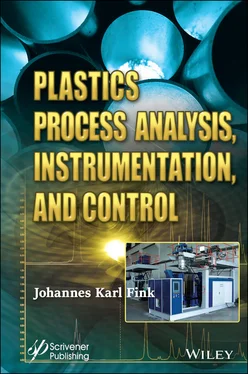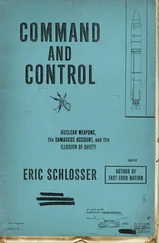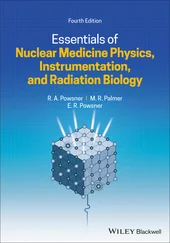1 The injection molding process (the transient temperature distribution inside the flowing polymer for a given mold temperature), and
2 The evolution of the mold temperature distribution for a given polymer temperature distribution.
The solution of one of the two processes can be used as a boundary condition for the other process and therefore the solution of the whole process can be obtained by alternatively considering the transient of one of the two processes, while the other is held at steady state, and vice versa.
To validate the proposed modeling of the heat exchange during the process, the simulated temperature evolutions at the polymer-cavity and the heating device-mold interfaces were satisfactorily compared with the experimental ones recorded during the tests conducted adopting different mold temperature evolutions. Furthermore, pressure evolutions during the process recorded at different positions along the flow path were satisfactorily compared with the simulated ones to validate the predictions of the thermomechanical histories experienced by the polymer (27).
Simulations and experiments were conducted with gas temperatures of 200°C to 400°C to investigate the impact of external gas-assisted mold temperature control on the quality of the weld line of molding products (29).
The general process consisted of six steps. In Step 1, as soon as the molding cycle was completed and the product was ejected, the hot gas source was transported to the heating area at which the cavity temperature was still low. In step 2, the hot gas sprayed directly into the heating area. Due to heat convection, the thermal energy was transferred to the cavity area, heating that area to the target temperature, after which the heating process stopped. At this time, the cavity remained at a high temperature. In Step 3, the gas drier was removed from the molding area and the two half molds were closed before a new molding cycle began by melt filling into the cavity in Step 4. In this step, the hot cavity allowed the melt to easily flow into the thin-walled area. As soon as the entire cavity filled, the cooling process started with the heat transfer from the hot melt to the mold plate in Step 5. The process stopped when the part temperature reached the ejection temperature. In Step 6, the two half molds opened to eject the part, and the next molding cycle occurred.
In the heating step, the heating rate was 19.6 ◦ Cs –1from 30°C to 128.5°C in the first 5 s in a 400°C gas environment (29).
When applied to heating the weld line area of an injection mold, the external gas-assisted mold temperature control improved the appearance of the weld line when the cavity temperature was preheated to 150°C.
For the tensile strength test, a melt flow simulation comparing the packing pressure of different mesh thicknesses revealed that external gas-assisted mold temperature control helped maintain a high pressure in the weld line area in different packing periods.
This was verified by an experiment where the external gas-assisted mold temperature control was applied with 400°C gas to change the mesh area temperature. The result indicated that an increase in the weld line area temperature from 60°C to 180°C improves the tensile strength of all mesh thicknesses, which was more pronounced with thinner parts, especially at 0.4 mm . The simulations revealed that high temperature is concentrated in the weld line area of the cavity surface, thus reducing the energy wasted during heating (29).
1.6.3.3 Momentary Mold Surface Heating
The momentary mold surface heating process heats the mold surface over 400°C in a few seconds with a gas flame, and then the surface is cooled down very quickly (30). A shiny surface with 98% light reflection was obtained using the momentary mold surface heating process for an injection molded part consisting of 30% glass fiber-reinforced poly(carbonate) (PC).
An additional piece of equipment to supply the gas fuel and air as well as the specially designed momentary mold surface heating mold is the only difference compared to a CIM system. The details of this injection molding approach using the momentary mold surface heating process have been reviewed (30).
Micro-injection molding is an important method for the fabrication of a microneedle array. Here, the mold temperature is one of the important factors that affect the mold-filling quality of the polymer melt during the micro-injection molding. An infrared heating method has been adopted to raise the mold temperature rapidly for improving molding quality of microneedle array (31).
According to the simulation of the reflector type, which has an important effect on the efficiency of the infrared heating system, an infrared heating system with high efficiency was developed and used in the infrared-heating-assisted micro-injection molding system. A series of verification experiments were carried out to verify the feasibility and the heating effect of the developed system.
The experimental results showed that the developed infrared heating system can achieve high efficiency and uniform heating of the mold surface and the infrared-heating-assisted micro-injection molding process for fabricating a microneedle array can improve the mold-filling capability of the polymer melt and optimize the replication quality of the parts, such as filling height, uniformity, and shrinkage (31).
1.6.3.5 Carbon-Bonded Graphene Coating
A carbide-bonded graphene coating on silicon insert was proposed to realize rapid thermal cycling (RTC) in injection molding. A continuous and dense carbon-bonded graphene coating was prepared on the surface of the silicon cavity through chemical vapor deposition (32, 33).
Serving as a thin film resistance heater, the graphene coating was able to heat the mold cavity rapidly to above the glass transition temperature of the polymer, even if the applied power source was of relatively low voltage. When the voltage was 240 V , the coating was heated up to 145.6°C in a short period of 10 s . So, the average and transient heating rates were able to be as high as 11.6 ◦ C s –1and 16.1 ◦ Cs –1, respectively.
This injection molding technique of RTC could be successfully implemented to produce plate samples with uniform sizes at a thickness of 600 μm (32).
Also, the influence of RTC on the weld line, internal stress, and replication fidelity was investigated. Compared with CIM, the here described method was able to mold products with smaller weld mark, less internal stress, and better replication fidelity. The tensile strength and elongation at yield of the products were also enhanced by 37.77% and increased by 265.11%, respectively, with much less energy consumption (32).
The graphene heater with a 48 Ω surface resistance made by a 60 min coating time proved to be the best choice for rapid heat cycle molding with regard to the heating efficiency (33).
The graphene heater was used in the rapid heat cycle molding of long-glass-fiber-reinforced PP composites to reduce the width and depth of the weld lines, decrease the floating fiber phenomenon, and improve the surface quality (33).
1.6.3.6 Induction Heating
Induction heating is a method that allows obtaining a rapid thermal cycle, so the overall molding cycle time is not increased (34).
Finite Element Model.To analyze the heating and cooling phase of an induction heated injection molding tool accurately, the temperature-dependent magnetic properties, namely the nonlinear B-H curves, an induction heating simulation has been performed (35).
Читать дальше












